A muddy hole in the ground becomes a great castle

The more of Kafka's stories that I read the stranger they seem to become. Well, it is not that the next one is stranger than the last, but rather that are all on the same level of strangeness. I guess that is what comes from somebody who has spent a bulk of his life working in the 19th Century version of Workcover. Hey, I work for an insurance company basically doing what Kafka did and, well, to be honest with you, it is driving me nuts as well. However, unlike Kafka, I don't have a PhD in Law, which makes you wonder what he was doing working in an insurance company processing personal injury claims.
From reading this story I gather than the person, or thing, telling you the story is a mole, though I am not all that willing to stake my life on that preposition. Okay, somebody has suggested that a statement where the narrator talks about a part of its forehead being used to burrow suggests that it is a mole, but there is another part of the story where the narrator suggests that it can see, and as far as I know moles are blind (though since I am not a zoologists, just some chump working for an insurance company, I cannot say for sure).
Anyway, the narrator, who appears to be a burrowing mammal of some sort, spends the entire story telling us about its burrow. However, the interesting thing about this story is that this particular mammal is describing this burrow from its point of view, which makes the whole labyrinthine structure so much more interesting. This is what I love about Kafka in that he seems to have the knack of turning one of the most boring things into a fascinating discussion. For instance, the main room is referred to as the 'Great Castle', while in reality it is just a muddy hole in the ground. The narrator also goes into intricate detail on how it stores its food, and also tells us about the beast that lurks nearby (though we don't know what the beast is, just that it is a beast). This is another thing that I love about Kafka, and that is that the way he uses language means that what he is describing could be anything. Once again, like Investigations of a Dog, we are seeing the world through the eyes of something that is not human, meaning that the world that we are looking at is not the human world.
In many ways Kafka's writings are absurd in that they expose the absurdity of life. Here we have a burrowing mammal who is describing what is in effect a muddy hole in the ground as if it were some exotic fortress and some fantastic palace. Yet we, the reader, know that it is little more than a hole in the ground. Yet, in another way it is an exotic fortress and a fantastic palace because that is how the owner sees the burrow. In a way it is our perception of something that counts, and not somebody else's, and the only reason that they may be suggesting that it is anything but is because they are jealous or envious of maybe, not so much the burrow, but the owner's happiness in inhabiting the burrow. Maybe then that is what the beast is, the jealous and envious person that goes out of its way to destroy one's happiness.


